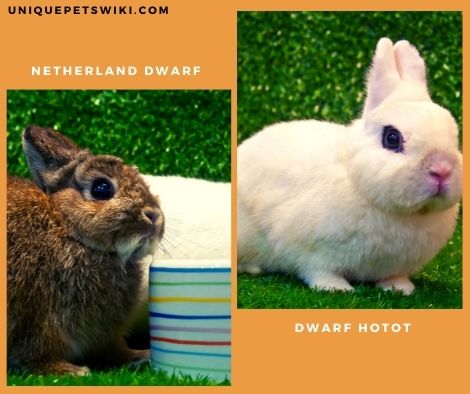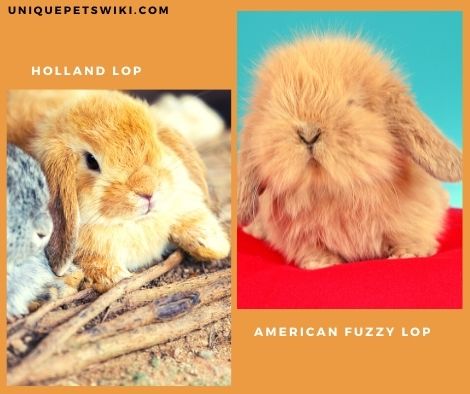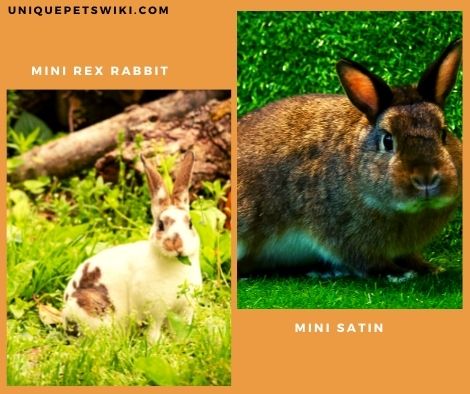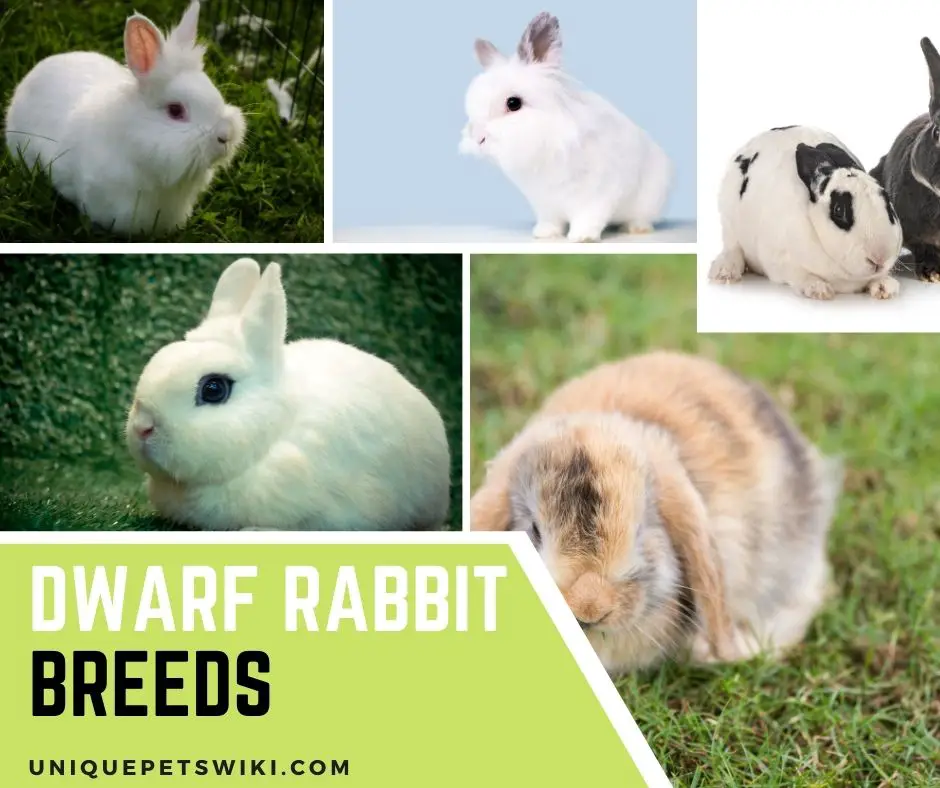Rabbits are undeniably cute animals—small in size with fluffy appearance. They’re cuddly, affectionate, and make great pets. With all the features rabbits in general have, Dwarf Rabbit Breeds are probably the cutest of them all!
Oftentimes, you get used to keeping common domestic pets, limiting them to cats or dogs. You might want to keep a pet that costs cheaper, looks smaller, and seems newer.
The main purpose of this article is to provide information about dwarf rabbit breeds. This will help you have more choices, save research time and money.
Contents
What Are Dwarf Rabbit Breeds?
Both female and male rabbits have the same size, but their average size only differs according to breed. The size of rabbits fall under three categories:
Some are small as a pygmy breed of about 8 inches in length and less than a pound in weight. Some rabbits can grow as big as a cat. Lastly, larger rabbit breeds can grow and weigh as much as 20 inches and 4.5 kilograms.
So much about various rabbit sizes, there are rabbits that are dwarfed. This is caused by a single gene in genetic relationship with Agouti. Dwarf rabbit breeds only weigh less than one (1) kilogram compared to giant breeds that weigh 10 kilograms.
Many of you might think that dwarf rabbits are small so they are just similar to other rabbit breeds, but they’re not. Dwarf rabbit breeds are the results of genetic mutation in HMGA2. There are actually 12 dwarf rabbit breeds recognized by ARBA, but let’s tackle the top 8 dwarf domestic rabbit breeds.
TOP 8 Dwarf Rabbit Breeds That You Can Keep as Pets
Have you ever wondered about going places with your beloved pets? But as much as you want to carry them whenever and wherever, you just can’t for the following reasons: Size, weight, needs, behavior.
So, one of the best options for common problems relevant to convenience is keeping a pet as handy as your mobile gadget—dwarf rabbit breeds. Here’s a table showing topmost rabbit breeds you can keep as pets:
| Dwarf Rabbit Breeds | Size (smallest to largest) | Appearance | Cost |
| Netherland Dwarf/Dutch Dwarf | 5”-6” (12.7-15.2 cm)/ 7.5”-9” (19-23 cm) | compact body, large head, short face, short ears, and large eyes. | $25-$75 |
| Dwarf Hotot | 2.5 to 3.5 lbs | Has white coat and black eye markings. Compact body, short neck and round head | $50 |
| Holland Lop | 2-3 inches | wide and short body type with stocky look | $20-$40 |
| American Fuzzy Lop | adult: 3-4 lbs bucks: 3-5lbsdoes: 3.75 lbs | rounded body, short broad face, floppy ears, and has wool | $50 |
| Jersey Wooly | 2.5 – 3.5 lbs | semi-arched body square, bold head erect ears (2-3 inches) and long shaggy coat | $20–$50 |
| Lionhead | 8-10 inches | a thick lion-like with single/double mane and high head mount | $50-$100 |
| Mini Rex | 3.5-4.5 lbs | rounded back with short, straight legs and a short neck. | $10-$50 |
| Mini Satin | 5 lbs | small and compact, slightly elongated body, and slender build | $50-$150 |
Netherland Dwarf
The Netherland Dwarf is as delicate as a flower. Their cuteness is indeed irresistible. Besides being the smallest rabbit breed, they have varying fur colors which give wonders to your eyes. Having this kind of dwarf rabbit breed is like keeping a pet as beautiful as its characteristics.
They can start off quite timid. They do not like loud noises or unexpected movements. You might want to give your new rabbit a lot of time to get used to its new surroundings.
You will need to monitor what they are eating and how they are expelling it. Schedule an annual visit to the veterinarian for a general wellness checkup.
They have minimal health complications, making them perfect for those shy about dealing with any health scares. They can live between 10 and 12 years. Also, they’re not always recommended for children.

Dwarf Hotot
They love affection and like to reciprocate whatever you make them feel. They’re undeniably vigorous and enjoy their own company.
Besides spoiling them with attention, they also require frequent brushing of fur during spring season; a lot of shedding happens during that time.
Feed them with filtered water and timothy hay, and they will just live healthily on their own. Just make sure to monitor their diet since they have a large appetite despite their small size.
The average lifespan of a Dwarf Hotot is 7 to 10 years. They’re recommendable for single pet owners.
Dwarf Hotot (pronounced as Oh-Toe) is a dwarf rabbit breed that has distinct features. It has an all-white fur and dark eyes that surely mesmerizes anyone in its gaze. It has cute little ears uncommon to rabbit breeds. You will definitely not feel bored with this vigorous mate.
Holland Lop
Holland lop is famously known for being calm, gentle, and obedient. They are full of curiosity and easily trained.
Their eating and drinking habits should be prioritized, their wastes should be monitored, and constantly observed for any changes in their appearance or behavior for immediate care.
Molts are common with Holland Lops, their coats need constant brushing to prevent them from swallowing hairballs. Their nails require trimming once a month. They require high veterinary treatment because their small round heads and flat faces often cause sinus issues and eye problems.
The Holland Lop lifespan is around 7 to 12 years, with some living up to 15 years of age if well taken care of. They’re actually good pets for families with children but medically not recommended due to forced breeding.
Holland Lop is commonly called the Dutch Little Hanging Ear because of its appealing lop ears hanging down the back of its head or framing its face. They are absolutely adorable with a cat-like pose. They’re very attractive yet easily fall ill.
American Fuzzy Lop
American Fuzzy Lops are sweet and energetic. They are playful and love to get attention from pet owners.
They don’t require daily grooming unless wool molts. Bathing should not be prolonged nor done regularly to avoid making them stressed. Make sure their hutch is clean and fresh water is always available.
Good thing about American Fuzzy Lop is that it’s not highly prone to diseases but wool blocks. So, practice proper grooming before wool thickens. They can also live from 5 to 8 years. They’re the kind of rabbit breed suitable for everyone.
American Fuzzy Lop is historically inclined with that Holland Lop. They’re overly active and love every attention they get. This dwarf rabbit breed is not only good as pets but also known for show purposes. Looking for an adorable low maintenance rabbit? Grab the chance of keeping a Fuzzy Lop.

Jersey Wooly
Jersey Woolies are affectionate and unaggressive. They love to snuggle owners and stuff. Moreover, they’re calm and playful.
Though Jersey Wooly has a thick coat, it doesn’t require high grooming needs. Their coat only needs to be brushed once a week, more so during shedding seasons. It’s highly recommended for them to be housed indoors.
They love to be petted but improper handling might cause them stress. Their average lifespan goes around 7 to 10 years.
Jersey Woolies are ultimately sociable. So, keeping two or more of this kind of dwarf rabbit breed is advisable. They’ll win the hearts of those aspiring pet owners through just showing their sweet nature. If you need a pet that’s well-suited for most lifestyles, this is your sign!
Lionhead
Lionhead loves to be petted when shown with love and affection. They are really uncomfortable with narrow spaces. Furthermore, they’re energetic and want to play around.
You need to give them time to adjust especially if they’re only new to your home. If they feel threatened by disrespecting personal space, they might bite you.
A regular veterinary treatment and checkup is a must since this kind of rabbit breed usually suffers from Malocclusion. Unlike any other rabbit breeds, they live longer for about 8 to 10 years. They can be a great pet for children
If you’re interested in keeping a pet with an incredible temperament, you have to learn more about Lionhead Rabbit. A pet whose head’s love to be stroked, a coat that needs to be groomed, yet showed no high-caring needs—a Lionhead indeed!
Mini Rex
Mini Rex are playful, happy-go-lucky, but easily frightened due to its prey nature. You always have to avoid sudden movements or impulsive responses since they tend to act as prey and might become aggressive if fear persists.
Pet owners should make time playing with them so it builds trust. Their food should not be limited to hay, and fresh water should also be readily available.
Dental problems are common for all rabbit breeds, so that’s given. But, they most likely suffer from Gastrointestinal Stasis. A balanced diet is needed. They usually live between 8-10 years, may even live up to 15 years if well taken care of.
Winning their trust is the key to getting their attention. They are purely domesticated pets and cannot be found in the wild unless under some circumstances. A great choice for a show breed, but definitely a pet to keep.

Mini Satin
Mini Satin should feel snugly with pet owners first before petting. They often get skittish with strangers, so provide them a safe and secure environment whenever. Just like other rabbit breeds, they’re gentle and sociable.
They are best for indoor care due to its small size. Their food and diet should not be limited to pellets and hay. Enclosures must be kept clean and changed in a week.
They are not really vulnerable to health diseases but ears should be regularly checked for some mites and flystikes. Their average life expectancy is between 5 to 8 years, but can live longer up to 12 years.
Families living in an apartment or any small space can keep a Mini Satin. Just a reminder, they’re better housed indoors.
Why Should I Consider Getting a Dwarf Rabbit?
Rabbits, particularly dwarf rabbit breeds, are becoming popular nowadays. They’re becoming a trend and labeled as the best (check out Actual Survey of Popular Rabbit Breeds for best options).
Apart from their adorable appearance, that is being jaw-droppingly cute, they’re absolutely sociable. Giving them a paramount of care, love, and attention, they’d be the best companion you could ever have.
Domestic pets have some things in common such as being playful, energetic, and sometimes aloof. However, they are not the same when it comes to shelter. Dwarf rabbit breeds are highly suggested as great indoor pets.
They’re susceptible to changing weather conditions. Thus, an indoor enclosure is recommendable. Dwarf rabbit breeds are small and will take up less space at home. They only need a space enough for them to play, roam, and settle with.
Also, they eat less. Their food and diet does not cost much unlike any other pets. They just need a supply of high-fiber food to munch and fresh water to quench thirst. They eat according to size.
Dwarf rabbit breeds are unique, cheap, handy, and proven as domestically great pets. Those reasons alone could excite you and probably lead you to get one impulsively. Once you learn more about their personality, caring requirements, health problems, and amazing long life expectancy, you’d have one for sure!
Issues Need To Pay Attention When Raising Dwarf Rabbit
Though dwarf rabbit breeds are sociable, small, gentle, and lovable, you need to pay attention to the common issues you might encounter when raising these rabbit breeds.
Dwarf rabbit breeds need a comfortable shelter to live in. They are highly suggested to be situated indoors. Given their small size, they won’t consume too much space. You can either purchase a hutch from a commercial store or make one yourself. Here’s a good read for a DIY hutch: Free Rabbit Hutch Plans.
Common problems with rabbits especially with dwarfed breeds fall with dental, digestive system, and monitored food diet. They need 70% of fresh hay to prevent problems with teeth and digestion.
Trimming your rabbit’s nails is a bit hard. If you’re confident and comfortable doing it, then do it yourself. But, it’s still recommended that proper grooming including the trimming of nails is done by a vet. Just a heads-up, their teeth can be trimmed as well if overgrown.
Wrapping Up
Dwarf rabbit breeds make good pets. They do not only look unique, they also have different characteristics. Keeping a pet as distinctively fragile as a dwarf rabbit requires a lot of research.
Learn the basics. Get to know about different breeds, their nature, then decide what breed makes a great addition to your household. Remember, they may not have high special needs, but they’re definitely worth loving and caring for.
